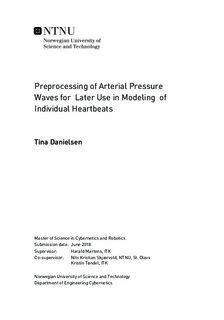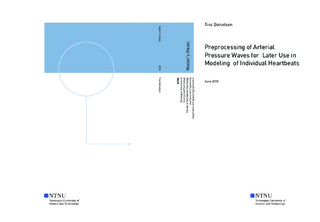| dc.description.abstract | Arterial pressure waves (APW) contain essential information, where the different shape of the waveform can indicate illness or essential information. Furthermore, there can be differences between subject independent of they are healthy or sick. The motivation for this thesis is to make individual models, such that the differences between subjects and the normality for one person is taken into account. In this thesis preprocessing of APW is performed and the purpose is to later use these preprocessing techniques before modeling individual heartbeats. The preprocessing have the goal of removing the baseline variations, remove the differences caused by different \ac{HR}, and separate the data into individual heartbeats.
The measurements of the data for seven healthy subjects in age 22-27 were performed by using The Human NIBP Set from ADInstruments, which is used to perform non-invasive blood pressure measurements from finger arterial pressure. The first step in the preprocessing was removing the baseline variations, and for this purpose, two different techniques were tried. The first technique was \ac{SG}-filtering and the second one was \ac{LOESS}. The second step was to interpolate the signal to get the same \ac{HR} for all the subjects. The third step was to identify the systolic peaks and then at last separate the data into individual heartbeats. Besides, \ac{MSC} was tried as a preprocessing technique for removing the additive and multiplicative effect. The study ends with some \ac{PCA} to study the possibilities of using the preprocessing techniques in further work.
The preprocessing with both \ac{LOESS} and \ac{SG}-filtering removes the baseline variations almost identically, and both methods give a satisfying result. However, the advantage with \ac{LOESS} is the possibility to find several frequency components and that \ac{LOESS} is a modeling method and not a filtering method. Furthermore, the result of the interpolation method shows a good result for the subjects with high \ac{HR}, but not optimal for subjects with a \ac{HR} around \SI{1.2}{Hz}. The systolic peaks function work correctly, and it never fails to find the systolic peaks or classify other peaks to be the systolic peak. The separation function works good, and in most of the cases, the next and the last heartbeat are excluded from the heartbeat. The result of the \ac{MSC} shows a good result for removing the additive and multiplicative effect, as long as there is not too much peak shifting.
Finding the respiration rate based on the baseline variations are hard since the baseline variations are influenced by the respiration rate, but are also other factors. This makes it hard to find the respiration rate only based on the baseline variations.
After the preprocessing a further analysis of the signals was performed, and then \ac{PCA} was performed to check if individual difference appeared in the \ac{PCA}. The \ac{PCA} shows that there are variations between subjects and inside subjects. It also shows that outliers like \ac{PVC} heartbeats appear in the \ac{PCA} model, which shows an opportunity to work further with the problem of finding an individual model for | |

